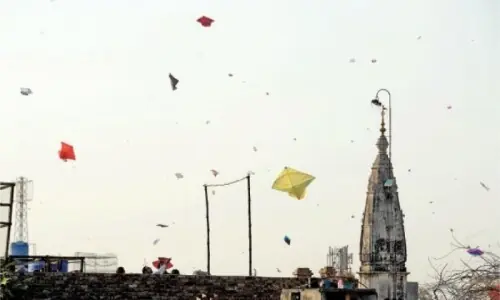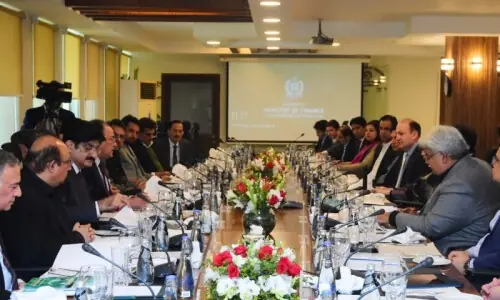 ISLAMABAD, March 30: The primary theatre of battle may still be North and South Waziristan, as evidenced by the Pakistani Taliban’s recent bloody assault on the settled town of Tank that borders the tribal areas. But the events of the last few days in Islamabad are more disturbing in some ways, suggesting as they do that creeping Talibanisation is now a reality across the country.Indeed the Lal Masjid brigade, as it has come to be known, has every right to celebrate. Tuesday’s showdown with the police was its second major success of the year. First its women’s wing, comprising hundreds of burqa-clad and baton-wielding students, occupied a children’s library in the federal capital in January.
ISLAMABAD, March 30: The primary theatre of battle may still be North and South Waziristan, as evidenced by the Pakistani Taliban’s recent bloody assault on the settled town of Tank that borders the tribal areas. But the events of the last few days in Islamabad are more disturbing in some ways, suggesting as they do that creeping Talibanisation is now a reality across the country.Indeed the Lal Masjid brigade, as it has come to be known, has every right to celebrate. Tuesday’s showdown with the police was its second major success of the year. First its women’s wing, comprising hundreds of burqa-clad and baton-wielding students, occupied a children’s library in the federal capital in January.
Now both the men’s and women’s wings of this emerging brand of the Pakistani Taliban have started to impose new rules of morality by forcibly shutting down video and music shops in Islamabad, and by abducting women whom they believe are engaged in ‘immoral’ activities.
Situated in an area where the prime minister’s secretariat and seat of power is on one side, and the headquarters of the country’s premier intelligence agency, the ISI, on the other, Lal Masjid and its adjacent Hafsa madressah have not only managed to enforce the Taliban-style system of ‘moral policing’ in matters of ‘vice and virtue’, to date they remain in control of the situation.
But who are these people, and why are the government and the security services finding it so hard to enforce the rule of law? Is it that the government really wants to avoid bloodshed because hundreds, if not thousands, of women are part of this violent brigade? Or is it a reflection of some kind of infighting in the establishment where one faction still has a soft corner for their former Islamist allies?
Led by two cleric brothers, the Lal Masjid brigade is a relatively new phenomenon in Pakistan’s militant politics. But the ambitious manner in which its leaders have sought publicity in the last few months has clearly set alarm bells ringing among the general public as well as sections of the security establishment.
Sons of Maulana Abdullah, a firebrand pro-jihad cleric who was assassinated inside the mosque about a decade ago, Maulana Abdul Aziz and Maulana Abdul Rasheed Ghazi have been running two separate wings of this movement.
Maulana Aziz, the more religious and scholarly of the two, heads Islamabad’s biggest Jamia Fareedia madressah, which is located in the woods near the elite E-7 sector on land allotted by the late General Ziaul Haq. At any given time, the madressah boasts over 7,000 students seeking higher degrees in Islamic education. But as has been the case during the present conflict, it also provides the bulk of the Lal Masjid militant force.
The younger brother, Maulana Rasheed Ghazi, known to be a worldly man, manages Lal Masjid. Once known for his close links with the establishment, he is now spearheading the Islamic ‘brigade’ which includes several thousand madressah students, both men and women.
Popularly known as Lal Masjid — probably after the building’s façade of red bricks — it has long been regarded as the city’s main mosque for the followers of the Deoband faith. It caught the eye of its detractors during the protest campaign by pro-Taliban forces in the aftermath of the 9/11 incidents and the US-led invasion of Afghanistan.
However, the critical point came when Lal Masjid hosted a major conference of ulema and clerics about four years ago to issue a fatwa which not only opposed the military operation in Waziristan but also called for a boycott of the namaz-i-janaza of soldiers killed in the fight with Islamic militants.
A number of people were arrested shortly after the fatwa was issued but Maulana Ghazi went into hiding. During this period the authorities made half-hearted efforts to arrest him, while Maulana Ghazi effectively used his contacts with the media for publicity and quickly transformed himself into the leader of the pro-Taliban movement in Islamabad.
The latest confrontation is also of his making, as was the case in January when he led the campaign against the demolition of mosques in Islamabad described by the government as illegal or unauthorised.
On that occasion, hundreds of burqa-clad women from the adjacent madressah Hafsa, all of them brandishing batons, occupied a small children’s library in protest. And though the controversy revolving round a demolished mosque was resolved with the religious affairs minister, Ejazul Haq, coming to their support, the library still remains in the control of the Hafsa women, and has in fact been made part of the madressah.
Encouraged by the manner in which the authorities capitulated, those managing Lal Masjid increased their demands, and called for regularising a large number of mosques constructed without prior permission. More recently they decided to push the campaign a step further by introducing the Taliban-style police system based on “amar bil maroof wah nahi anil munkir”, more commonly known as the ‘department of vice and virtue’.
Within no time groups of men and women from the brigade started visiting shops, threatening them with dire consequences if they didn’t stop selling DVDs, CDs or music cassettes. People were also issued directives about dress codes and other ‘moral and ethical’ issues.
The latest confrontation, which again ended in victory for the Hafsa women, was also the result of this campaign during which they raided a nearby house and abducted an elderly woman as well as her daughter and daughter-in-law, accusing them of immorality.
The authorities, meanwhile, focused on securing the release of two policemen who had been made hostage the same day by the Lal Masjid boys. The women were set free only a day later, and that too after being forced to seek ‘forgiveness’. All this happened not somewhere in remote and distant Miramshah or Wana, but a stone’s throw from the seat of power.
The situation today is that the leaders of Lal Masjid are declaring victory in this latest round. The children’s library is still in their control, and their baton-wielding force patrols the streets in the area. The authorities keep claiming that a number of wanted men are hiding inside the mosque but remain reluctant to take action. The excuse they offer is that the use of force may result in bloodshed. That brute force was used only a few days ago to crush opposition supporters a few hundred yards from Lal Masjid is easily forgotten.
Lal Masjid is supported by not only the Hafsa and Fareedia madressahs but also has the backing of a dozen or so other large and small seminaries in different parts of city. And their students — almost all of them from outside the city — can assemble at the shortest possible notice, as has been witnessed during recent protest gatherings.
To some it seems the government doesn’t realise the gravity of the situation. And that has prompted a few to ask if a government even exists in Islamabad.
But of course there is a government, with Mr Shaukat Aziz sitting pretty in the palatial and well-secured Prime Minister’s House on the hill. President Pervez Musharraf, with much already on his plate, is meanwhile busy trying to solve issues more crucial to him, ranging from the judicial crisis to Waziristan, and even the Islamic ummah’s wider concerns like Palestine and Iraq.
To them the stand-off in Islamabad may not yet be a huge crisis as has been the case with crises in the past. It may take a while for the decision-makers to understand how dire the situation has become. In the meantime, the creeping coup by the Pakistani Taliban will continue unchecked to challenge the writ of the government and the state. And perhaps alter the country’s social fabric to an extent that it is rendered unrecognisable.

































